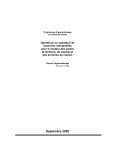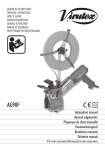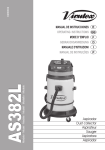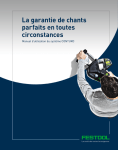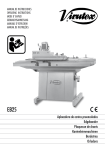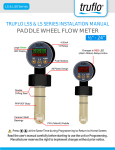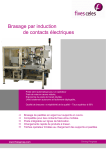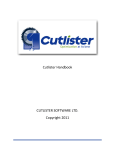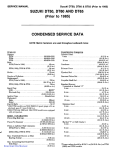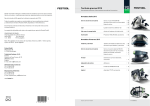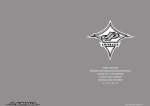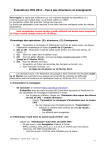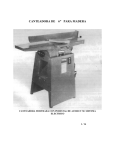Download Aplacadora de Cantos Preencolados Edgebander
Transcript
6396058 MANUAL DE INSTRUCCIONES E EB25 Modelo · Model · Modèle · Modell · Modello · Modelo OPERATING INSTRUCTIONS USA GB MODE D' EMPLOI F GEBRAUCHSANWEISUNG D MANUALE D'ISTRUZIONI I MANUAL DE INSTRUÇÕES P Aplacadora de Cantos Preencolados Edgebander Plaqueuse de Chants Kantenleimmaschinen Bordatrice Orladora MANUAL DE INSTRUCCIONES OPERATING INSTRUCTIONS MODE D'EMPLOI GEBRAUCHSANWEISUNG MANUALE D'ISTRUZIONI MANUAL DE INSTRUÇÕES página/page seite/pagina ESPAÑOL ENGLISH FRANÇAIS DEUTSCH ITALIANO PORTUGUÉS Fig. 1 Aplacadora de Cantos Preencolados EB25 EB25 Edgebander Plaqueuse de Chants EB25 Kantenleimmaschinen EB25 Bordatrice EB25 Orladora EB25 5 8 11 14 17 20 Fig. 2 Fig. 3 2 Fig. 4 B S J L A N1 K R1 Fig. 5 Fig. 6 G Fig. 7 H1 F D C G1 H E Fig. 8 Fig. 9 J K Y I L U R Fig. 11 Fig. 10 M J1 N P 3 Fig. 12 Fig. 13 X S X V Fig. 14 Fig. 15 CORTE 2 W Z CORTE 1 X1 A1 B1 C1 D1 C1 Fig. 16 bis Fig. 16 Fig. 17 Fig. 18 K1 F1 4 L1 Fig. 19 M1 ESPAÑOL APLACADORA DE CANTOS PREENCOLADOS EB25 1. INSTRUCCIONES DE SEGURIDAD PARA EL MANEJO DE LA APLACADORA - ¡ATENCIÓN! Lea atentamente el FOLLETO DE INSTRUCCIONES GENERALES DE SEGURIDAD, que se adjunta con la documentación de la máquina. - Asegúrese antes de enchufar la máquina, que la tensión de alimentación, se corresponda con la indicada en la chapa características. - Mantener siempre las manos alejadas de las áreas de corte y las zonas de temperatura. - Use siempre recambios originales VIRUTEX. - No use nunca cuchillas defectuosas o en mal estado de corte. 2. CARACTERÍSTICAS TÉCNICAS Potencia absorbida..........................................3000W Motor......................................50 Hz · opcional 60 Hz Nivel de presión acústica continuo equivalente ponderado...............................82,9 dB(A) Grueso mínimo a cantear.................................11 mm Grueso máximo a cantear................................50 mm Regulación electrónica de la Temperatura......0-500°C Velocidad de trabajo...................................4,2 m/min Peso.................................................................117 Kg 3. EQUIPO ESTANDAR Al abrir la caja de embalaje, encontrará en su interior los elementos siguientes: 1. Aplacadora de cantos preencolados EB25 2. Cjto. soporte desplazable 3. Cjto. lateral derecho 4. Cjto. lateral izquierdo 5. Caja conteniendo: - Cargador cinta - Soporte cargador - Cjto. prensor - Prolongación enchufe - Juego de llaves 6. Documentación. 4. DIMENSIONES APLACADORA El espacio ocupado por la Aplacadora, está representado en la (Fig. 1). 5. ENSAMBLAJE Y PUESTA EN MARCHA 1. MONTAJE DE LOS LATERALES SUPERIORES DEL MUEBLE Cada lateral dispone de cuatro tornillos de M6x15 y dos clavijas de situación, debiéndose proceder para su montaje de la forma siguiente (Fig. 2): - Sacar los cuatro tornillos A de la mesa, posicionar el lateral P1 mediante las dos clavijas S1 con el lateral de la mesa. - Roscar en sus alojamientos de la mesa, los dos tornillos superiores A de dicho lateral y dejar apretados definitivamente. - Roscar los otros dos tornillos A inferiores. - Nivelar el lateral con la mesa del mueble, mediante una regla y hacer dicha regulación con los tornillos T1, asegurando su regulación mediante su tuerca correspondiente, Una vez realizada esta operación, terminar de apretar los dos tornillos anteriores A. - Seguir el mismo procedimiento para el otro lateral de la máquina. 2. MONTAJE DEL SOPORTE CARGADOR (Fig. 3) - Desenroscar los tornillos U1 de su alojamiento. - Colocar el soporte W1 y fijar éste, mediante los tornillos U1. - Colocar el cargador cinta B comprobando que gire libremente. 3. MONTAJE DEL SOPORTE DESPLAZABLE Para montar este conjunto soporte desplazable se procede de la forma siguiente (Fig. 4): - Extraer de la guía soporte desplazable J, el tornillo K que fija el turrión L en uno de sus extremos. - Colocar el soporte desplazable S y volver a montar 5 comprobando su correcto engrane con todas las poleas dentadas. Tensar nuevamente la correa mediante el desplazamiento de la polea tensora con una presión suficiente para que cuando esté en funcionamiento efectúe un buen arrastre. 17. NIVEL DE RUIDO El ruido de ésta herramienta eléctrica, está medido según ISO/DIS 230/5. El nivel de ruidos en el puesto de trabajo puede sobrepasar 85 dB(A). En este caso es necesario tomar medidas de protección contra el ruido para el usuario de la herramienta. 18. RECOMENDACIONES Para cualquier manipulación de mantenimiento en la máquina, desconectar ésta de la red eléctrica. Conservar el cable de alimentación y el enchufe en buenas condiciones. Para obtener un buen recorte de la cinta preencolada, debemos trabajar con las cuchillas limpias de cola y bien afiladas. También la máquina, debe encontrarse limpia de cola y recortes de cinta, para evitar posibles atascos en el desplazamiento efectuado por la cinta preencolada. La presión que efectúe el alimentador sobre la superficie de los tableros, debe ser la necesaria para el arrastre de los mismos. Una presión en exceso, provoca un deterioro anticipado de la correa de arrastre. También es conveniente, que la superficie de la misma, esté limpia de restos de cola o de cuerpos extraños, con el fin de obtener un perfecto arrastre. Para la limpieza de las cuchillas, se recomienda la utilización de nuestro CANTSPRAY (spray antiadherente sin silicona). 18. GARANTÍA Todas las máquinas VIRUTEX, tienen una garantía válida de 12 meses a partir del día de su suministro, quedando excluidas todas las manipulaciones o daños ocasionados por manejos inadecuados o por desgaste natural de la máquina. Para cualquier reparación, dirigirse al Servicio Oficial de Asistencia Técnica VIRUTEX. VIRUTEX se reserva el derecho de modificar sus productos sin previo aviso. ENGLISH EB25 EDGEBANDER 1. SAFETY INSTRUCTIONS FOR EDGEBANDER USE - WARNING! Read the GENERAL SAFETY INSTRUCTIONS LEAFLET, which is included in the machine documentation, carefully. 8 - Before connecting to the mains ensure that the supply voltage corresponds that shown on the specification plate. - Always keep hands away from the cutting zone and hot areas. - Always use original VIRUTEX spare parts. - Never use damaged or worn blades. 2.TECHNICAL SPECIFICATIONS Input Power.................................................3000 W Motor................................50 Hz · optional 60 Hz Equivalent measured continuous acoustic pressure level.........................82.9 dB(A) Min. edging thickness....................................11 mm Max. edging thickness...............................50 mm Electronic temperature control................0-500°C Working speed.......................................4.2 m/min Weight......................................................117 kg 3. STANDARD EQUIPMENT On opening the box, you will find the following items inside: 1. Edgebander EB25 2. Sliding support assembly 3. Right side assembly 4. Left side assembly 5. Box containing: - Tape loader - Loader mounting - Clamp assembly - Extension lead - Set of keys 6. Documentation 4. EDGEBANDER MEASUREMENTS The space occupied by the Edgebander is shown in (Fig. 1). 5. ASSEMBLY AND START UP 1. MOUNTING OF UPPER SIDES OF MACHINE Each side has four M6x15 screws and two locating pegs. The following procedure should be followed for mounting (Fig. 2): - Remove the four screws A from the table and position side P1 using the two pegs S1 against the side of the table. - Screw the two upper screws A of the above mentioned side into the table and tighten fully. - Screw in the two lower screws A. - Level up the side with the machine table using a ruler by adjusting the two studs D. Once this operation is completed tighten up the two lower screws T1, ensure that they are properly adjusted using the corresponding nut. Once this operation is completed, tighten up the two lower screws A. - Follow this procedure for the other side of the machine. 2. MOUNTING OF THE LOADER SUPPORT (Fig. 3) - Unscrew the screws U1 from their positions. - Position the support W1 and secure it using the screws U1. - Position the tape loader B, ensuring that it turns freely. 3. MOUNTING OF THE SLIDING SUPPORT In order to mount this sliding support assembly the following procedure should be observed (Fig. 4): - Remove from the sliding support guide J, screw K which holds the peg L at one of its ends. - Position the sliding support S and reassemble to its previous state. - Level the sliding support S with respect to the table using a ruler and by adjusting screw K. - Proceed in an identical manner with the other sliding support guide. - Check the correct sliding of the assembly inside the guides. 4. DESCRIPTION AND START UP The machine has a safety switch (on-off) A on its right-hand side (Fig. 5). This is to safeguard against unexpected start-ups as well as a for connecting the machine and electrical overload to the mains. This should be carried out by means of an extension cable with conductor and earth, using conductors suitable for a nominal intensity of 16A. Next to the loader B, (Fig. 5), are the machine remaining controls (Fig. 6), which consist of an emergency switch C, on-off switch for the heater F, on-off switch for the feeder motor D, indicator light E showing on-off status of the machine and a regulating button G to adjust the temperature of the heater. To start up the machine, press the green button R1 (Fig. 5) to supply voltage to the machine. Pilot E lights up. Then flick heater switch F and feeder motor switch D to On. If the machine receives an electrical overload, switch N1 will be deactivated, cutting off the supply voltage. In order to re-establish supply, it will first be necessary to flick thermal switch N1 and repeat the above steps. If the emergency switch is used, this immediately deactivates all the machine functions, making it necessary to reset this switch by turning it in the direction f the arrow and to press the green start-up switch (Fig. 5) in order to recommence work. Place a roll of pre-glued tape in loader B (Fig. 5). Its width must correspond to the thickness of the board to be edged; we recommend using a tape 3 mm wider than the board's thickness in order to achieve perfect trimming. Place the pre-glued tape in the tape guide and adjust the height of guides I (Fig. 8) to the width of the tape, using knob J, which raises or lowers guide I, and ensuring that the tape moves smoothly. Move the tape manually to the cutting edge and place a panel on the table, supporting it on the front of control box U (Fig. 9), and move it over the milled roller to check that the tape is moving smoothly between the guides. If no obstacles are observed, move the tape back as far as the cutting edge using knob K (Fig. 8), ensuring that the tape is moving correctly against the panel. Close the feeder and start the machine by pressing the green on-off button R1 (Fig. 5). 6. TEMPERATURE CONTROL Before carrying out this operation it is important to take the precaution of checking that the tape is not in front of the air outlet from the blower L, (Fig. 9) to prevent it overheating and thus damaging the preglued tape. Start the heater by moving switch F (Fig. 6) to position 1. To raise the temperature more quickly, turn the electronic control G, (Fig. 6) to number 9 on the control scale and watch the temperature rise quickly. Once it has reached 300°C turn the knob to point 5 on the scale and once the needle has stopped moving, the temperature can be adjusted to the correct level for the pre-glued tape we are using. 7. STRAIGHT EDGING, TRIMMING AND FLUSH CUTTING The machine leaves the factory prepared for this type of work and the only adjustments needed are for the pre-glued tape width and the width between the trimming blades for the panel to be banded (the adjustment for pre-glued tape width has already been explained in section 5. ASSEMBLY AND START UP). To adjust the trimming blades and place them in working position follow the instructions in the section on 11. ADJUSTING THE BLADES (Fig. 10). The minimum measurements of panels for this edging work are the following: Minimum width 102 mm and 175 mm minimum length. 8. REGULATING EXCESS TAPE AT REAR When banding, if there is an excess or lack of preglued tape at the rear, the tape can be adjusted moving lever M1 (Fig. 19) slightly to the right or left according to the indication (+,-) on the machine. 9. CLAMP ASSEMBLY The machine is equipped with two clamps X, (Fig. 13) fixed to the extension guide S, which push the panel from the side of panel on rollers. It is advisable to place clamp X on the left of the extension guide S, i.e. at the feeder outlet, to ensure correct trimming. 10. CHANGING THE TRIMMING BLADES For ease of access to the motorised trimmer open the feeder by loosening handle H, (Fig. 7). Remove all of the protection devices which cover the unit by removing the three screws Y on each side, (Fig. 9). Remove screws Z which secure the belts unit to pulley W and remove the pulley, (Fig. 14). Remove screws A1 which hold the blades in place, 9 (Fig. 15). Remove the blades. The blades cut on both sides of the teeth (cuts 1 and 2) so that the second cut can be used before it is necessary to change them, by placing the lower blade in the upper mounting and vice versa, (Fig. 15). WARNING! After carrying out any work inside the Trimming Unit always replace the protection devices in their original positions. 11. ADJUSTMENT OF THE TRIMMING BLADES Using knob M raise the upper blade holder until the panel can pass beneath it, (Fig. 10). Insert the panel between the four supporting rollers N, until it touches the shoe P on the blade holder. Check that the lower blade holder rollers raise the panel slightly above guides R, (Fig. 9). Using knob M lower the upper blade holder until the panel is sitting on the guides R. The trimmer is now ready for work. 12. ADJUSTMENT OF THE EXTENSION GUIDE 1. Loosen knobs T, (Fig. 1) and place the machine extension guide S, (Fig. 13), in such a position that the panel is well supported on guides R, (Fig. 9) touching the front U (Fig. 9) on the control box. 2. Push the wood forward until it is picked up by the feeder, at which point we can let it go, as it is guided with sufficient pressure to stick the pre-glued tape to the edge. 3. As the panel moves through the machine, it goes through the motorised trimmer where the excess tape is trimmed off from both sides of the panel. 4. After this process the panel is moved on and as it leaves the feeder it is pressed against a blade V, (Fig. 12), which cuts off any remaining excess preglued tape. 5. The final product is a panel on which the pre-glued tape has all been trimmed and the edges are flush cut. 13. CHANGING THE TRIMMER BELTS Remove the protective devices which cover the unit by removing the three screws Y from each side, (Fig. 9). Remove the used toothed belt and replace it with a new VIRUTEX original spare lining it up correctly with the teeth on the pulley without forcing it, (Fig. 14). 14. CHANGING THE TRIMMER BRUSHES Disconneet the connection cable of the motorised trimmer. Remove the motorised trimmer from its housing in the machine, loosening screws X1 (Fig. 14). Remove screws B1 from the protector D1, removing the latter from its housing and cover (Fig. 16). Raise springs C1 (Fig. 16 bis) which hold the brushes in place and replace the brushes with VIRUTEX original spares, ensuring that they move smoothly inside the guides. Replace the cap D1. It is recommendable to leave the trimmer running for 10 10 minutes without working to shape the brushes better. If any roughness or damage is observed on the collector, we recommend you have it repaired at a VIRUTEX service point. Never use sandpaper for this operation. 15. ADJUSTMENT OF THE FEEDER Loosen the handles F1 and G1, (Fig. 17 and 7). Position the feeder index to the measurement corresponding to the thickness of the panel by turning the wheel H1, (Fig. 7). Tighten the handles F1 and G1, (Fig. 17 and 7). Open the feeder using handle H, (Fig. 7) in order to see the height of the trimmer blades, and adjust the height if necessary, (section 11. ADJUSTMENT OF THE TRIMMING BLADES). The lamp E, (Fig. 6) on the indicator panel when opening the feeder. Once the trimmer blades have been adjusted close the feeder using handle H, (Fig. 7), leaving a slight angle with respect to the rollers on which the panel moves. Thus, when the feeder is operating the panel will always be pressed against the corresponding rollers when it is being pulled through the machine. Press safety switch R1, (Fig. 5), to connect the current to the machine. 16. CHANGING THE BELT Remove the three screws J1, (Fig. 11) and take off the cover. Loosen the tensor pulley K1 and slacken the belt if necessary, (Fig. 18). Replace the belt L1 with another original VIRUTEX, checking that it correctly meshes with all the toothed pulleys. Tension the belt by sliding the tensor pulley in order that it gives a good drag when in service. 17. NOISE LEVEL The noise generated by this electrical machine is measured according to ISO/DIS 230/5. The noise level in the workplace could exceed 85dB(A). In this case the necessary precautions against noise should be taken by the user of the equipment. 18. RECOMMENDATIONS For any work involving handling of the machine, disconnect from the mains. Maintain the supply cable and plug in good condition. In order to obtain a good cut of the tape we should always work with sharp, glue-free blades. The machine must also be kept clean and free of glue and tape cuttings in order to avoid the pre-glued tape becoming jammed. The pressure the feeder exerts on the surface of the panels through the machine as excess pressure will cause increased wear on the feed belt. It is also recommended that the surface of the belt be kept clean and free of glue and foreign bodies in order to obtain perfect pulling of the panels. For cleaning the blades, we recommend use of our CANTSPRAY (nonadherent silicone-free spray). la (Fig. 1). 19. GUARANTEE All VIRUTEX machines are guaranteed for 12 months from the date of supply, excluding any damage which is a result of incorrect use or of natural wear and tear on the machine. All repairs should be carried out by the official VIRUTEX technical assistance service. 5. ASSEMBLAGE ET MISE EN MARCHE 1. MONTAGE DES PANNEAUX LATÉRAUX SUPÉRIEURS DU MEUBLE. Chaque panneau latéral dispose de quatre vis de M6x15 et de deux clavettes de situation, le montage devant être effectué de la façon suivante (Fig. 2): - Retirer les quatre vis A de la table, positionner le panneau latéral P1 à l'aide des deux clavettes S1 sur le côté de la table. - Visser les deux vis supérieures A de ce panneau dans leurs logements de la table et les serrer définitivement. - Visser les deux autres vis A inférieures. - Niveler le panneau latéral avec la table du meuble à l'aide d'une règle et faire le réglage avec les vis T1, assurant son réglage à l'aide de leur écrou correspondant. Après avoir réalisé cette opération, terminer de visser les deux vis antérieures A. - Suivre le même procédé pour l'autre panneau latéral de la machine. VIRUTEX reserves the right to modify its products without prior notice. FRANÇAIS PLAQUEUSE DE CHANTS EB25 1. INSTRUCTIONS DE SÉCURITÉ POUR LE MANIEMENT DE LA PLAQUEUSE. - ATTENTION! Lire attentivement la BROCHURE D’INSTRUCTIONS GÉNÉRALES DE SÉCURITÉ, jointe à la documentation de la machine. - Avant de brancher la machine, s'assurer que la tension d'alimentation correspond à celle indiquée sur la plaque des caractéristiques. - Maintenir toujours les mains éloignées des zones de coupe et des zones de température. - Utiliser toujours des pièces de rechange d'origine VIRUTEX. - Ne jamais utiliser de couteaux défectueux ou en mauvais état. 2. CARACTÉRISTIQUES TECHNIQUES Puissance absorbée.......................................3000 W Moteur................................50 Hz · en option 60 Hz Niveau de pression acoustique continu équivalent pondéré....................................82,9 dB (A) Largeur minimum..............................................11 mm Largeur maximum.........................................50 mm Réglage électronique de la température.........0-500°C Vitesse de travail....................................4,2 m/min Poids.............................................................117 kg 3. ÉQUIPEMENT STANDARD Dans la caisse d'emballage, vous trouverez les pièces suivantes: 1. Plaqueuse de chants EB25 2. Ens. support déplaçable 3. Ens. panneau latéral droit 4. Ens. panneau latéral gauche 5. Caisse contenant: - Chargeur bande - Support chargeur - Ens. presseur - Rallonge prise - Jeu de clés 6. Documentation 4. DIMENSIONS DE LA PLAQUEUSE L'espace occupé par la plaqueuse est représenté sur 2. MONTAGE DU SUPPORT CHARGEUR (Fig. 3) - Dévisser les vis U1 de leur logement. - Placer le support W1 et le fixer, à l'aide des vis U1. - Placer le chargeur de bande B en vérifiant qu'il tourne librement. 3. MONTAGE DU SUPPORT DÉPLAÇABLE Pour monter cet ensemble support déplaçable, on procède de la façon suivante (Fig. 4): - Retirer du guidage support déplaçable J, la vis K qui fixe le tourillon L à l'une de ses extrémités. - Placer le support déplaçable S et le remonter comme il était. - Niveler avec une règle le support déplaçable S par rapport à la table à l'aide de la vis K. - Procéder de la même manière avec l'autre guidage support déplaçable. - Vérifier le déplacement correct de l'ensemble dans les guidages. 4. DESCRIPTION ET MISE EN MARCHE La machine dispose d'un interrupteur de sécurité (marche-arrêt) A, sur le côté droit (Fig. 5). Cet interrupteur sert de protection contre les démarrages intempestifs de la machine, contre surcharges de courant et également, de prise de courant pour brancher la machine sur le secteur, ce branchement devant être réalisé à l'aide d'une rallonge pourvue d'un conducteur et d'une prise de terre et avec les conducteurs appropriés pour une intensité nominale de 16 A. Près du chargeur B, (Fig. 5), se trouve le reste des commandes de la machine, (Fig. 6), celle-ci étant pourvue d'un interrupteur d'arrêt d'urgence C, un interrupteur de mise en marche et arrêt du radiateur F, un interrupteur de mise en marche et arrêt du moteur poutre d'entraînement D, un voyant lumineux 11









